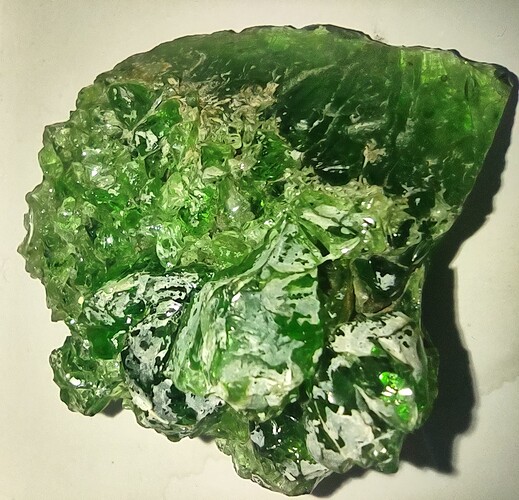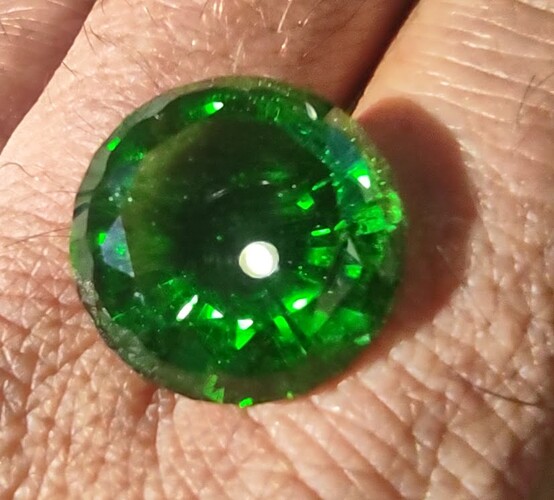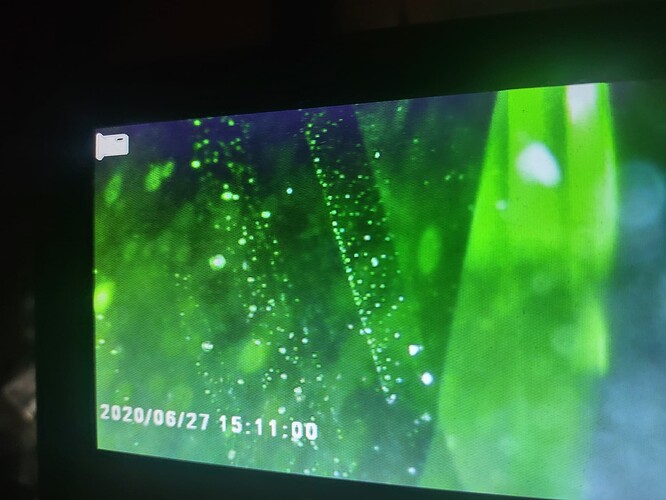From an ancestors collection, who was USGS geologist, and miner. Unknown location. It’s been called man-made glass several times and was wondering what indication there might be of this opinion besides bubbles, since “bubbles” can occur in natural materials also? These inclusions are not all round or tear drop shaped.
Hardness 6-7. SG-2.52. Probably not garnet but that was the initial tentative ID of a knowledgeable person, before SG was done. I don’t think Chrysoprase forms like this, but not sure.
Have you tried looking through the specimen from various angles to see if you can detect any doubling of facet edges or other similar features?
Garnets belong the the Cubic Crystal system, while Chrysoprase (quartz) is Trigonal.
Any doubling, anywhere, from any angle rules out garnet.
Hi and thanks for the suggestion. It is singly refractive. I’m not at all knowledgeable in this but think it would be in the cubic crystal system. Does that look right from the rough pics?
I don’t think anyone could determine the crystal system from the pictures.
If the specimen is singly refractive, it is by definition of the Cubic system.
Be careful about concluding the specimen is cubic though.
You really need to examine it from 3 mutually perpendicular directions, preferably under magnification, and be totally unable to find any doubling, to rule out chrysoprase, using edge doubling as the determining factor.
I’d find a table of common minerals, listed by crystal system, to look for other minerals in the cubic system that might look like garnet - peridot might be a possibility, it’s also green and cubic.
Have you thought about getting a gemology book and some lab instruments?
Peter Read’s “Gemmology” is a good , basic book.
Even just a good Hastings triplet 10x loupe would help.
One addition thing I forgot to mention:
“Chrysoprase” is a type of “microcrystaline”, or “cryptocrystaline” quartz, - made of a myriad of tiny crystals, fused together, so the pics you show couldn’t be that.
Green monocrystaline quartz, unless it’s very pale green is probably coated with titanium or something.
Chrysoprase is not transparent. A polariscope can tell you if your stone belongs to the cubic system. However, the bubble inclusions and low SG suggest glass and that could be confirmed by a refractive index measurement.
I agree that chrysoprase is not transparent, altho’ really good chrysoprase can come close. If it is singly refractive and your numbers on SG and hardness are correct, I can’t think of anything but glass…however, distinguishing whether it is a tektite or a synthetic glass can be very difficult. The faceted stone looks brighter than most tektites, but that isn’t conclusive. You might take it to some local university geologists. If it becomes a real head scratcher, maybe they have lab instruments or will recommend you send it to GIA. -royjohn
Thanks again, both of these and several others have been head scratchers. I think largely due to the fact that I don’t know where my family member had found this one, and there hasn’t been reported findings at the site in WA. Also, I’ve been told they both contain ‘bubbles’, which look like two-phase inclusions to me, but that and the fact they’re transparent has most people convinced it’s glass, or a man-made product. I’m fairly certain that neither are either one. In large part because I don’t believe my great grandfather would’ve been saving man made glass when he was a geologist and miner. I don’t mean to be dismissive, or acting like a know it all, while I know next to nothing in this field. It’s mainly that I’ve had so many widely varied identifications and knowing that not many stones ‘sparkle’ like these. This green stone displays high brilliance and the other shows fire similar to diamond.
If he lived in Washington state, you might consider Mt St Helen’s volcano glass.
It would have been an obvious Washington collectors item. And it facets beautifully.
Thanks again for the info. I’ve been looking in books and online for a few years now. It hasn’t been coated with anything. XRF analysis says Ca- 64.96%, Fe- 25.74%, Sr- 5.73%, As- 1.63%, Zr- 1.47%. The lapidary gave me SG-1.33, my SG- 1.51. Hardness- 6-7.
The ancestor who found it did a bit of travelling and a lot of collecting, I don’t have the names or locations of any of his though, as the paper was too old and brittle to read or touch. Helenite is a possibility, I’m not sure if Helenite or chrysoprase forms the crystals shown in the rough pics though and I think he likely collected it before Helenite was formed. I think they’re both amorphous too, right?
I think the crystalline structure in pics of the rough probably rule out tektite, but I’m not sure. Is there a type of scapolite that could be a possibility?
I don’t see a crystalline structure on your rough piece myself in the one view you are showing. You’ve misstated the SGs in your latest post, I am assuming you meant 2.33 and 2.51. Those two are an awful far way apart, so I’m wondering what the correct value really is and how the hardness estimate was achieved. It’s hard to do gemology with no instruments unless you know Hdgkinson’s visual optics and that is not always completely conclusive. It think I would start by getting someone to do an RI on this…that should tell you whether it is singly refractive or not. If it really is, then you can take a list of gems which are in your SG range and find the one or ones in your RI range. If you had a polariscope, you could determine whether it is a cubic crystal or not. If it isn’t, then its amorphous, and that leaves us with some kind of glass. The Helenite was something that some sellers claimed was glass from the eruption of Mt. Helens, but a GIA analysis (the paper is available on line) concluded that it was a glass which contained about 10% of ash from Mt. St. Helens. As far as glass bubbles are concerned, they are usually larger than the bubble fingerprints in some gems, but perhaps not in all types of glass.
-royjohn
You’re right, I did mean he got 2.33 and I got 2.51. He did say it’s singly refractive and gave an RI, I didn’t write it down before it was erased after 24hrs. I agree the SGs are very different, but the ones he and I did on another gem were within .01, and I repeated it multiple times getting an avg of 2.51. The hardness tester is a good set for gemstones testing. I also have a spectroscope and wish I could take a pic of what it shows. Do you know of any good reference books for comparing those findings?
A nice simple first gemology book is Gem Identification Made Easy by Antoinette Matlins and A.C. Bonanno. It’s now in a sixth edition, but you can probably find it used in earlier editions…some of the latest info on synthetics may not be included and there will probably be some new info on synthetic diamonds, but otherwise the info on most stones is the same.
Gemology Tools Professional is software that allows you to input whatever data you have (e.g., SG, RI, hardness, spectra, magnetism data, and so on) and then gives you a list of possible gems and advice on what to measure next. It is $69.95.
A classic is Webster’s Gems: Their Sources Description and Identification. Peter Read’s text on Gemology is used as study material for the FGA.
I looked at your data again and pulled out Matlins book, which has a table of singly refractive gems. Your fairly low SG eliminates most of them. RI and SG are correlated, and a low SG means a fairly low to medium RI. Since your gem can’t be garnet or spinel, diamond or YAG, etc., I think the only singly refractive alternatives are glass, obsidian or moldavite. Google moldavite and you will see some rough with a surface that looks to me to be identical to your specimen. However, the green you have in the faceted stone is brighter than moldavite is, so it could be fake moldavite, which is known. I am assuming that you are sure that the gemstone and the rough have the same measured values.
Any form of glass is not particularly brilliant compared to high RI materials, although it can have a higher RI than typical glass…as high as 1.77. And some glasses do have high dispersion, altho’ the high RI glass I know about is leaded glass, which is softer than you report.
Your cut stone looks like tsavorite, but it can’t be that because the SG is way too low.
I’ll bet if you get a polariscope, you’ll find this is not a cubic crystal, so it would have to be amorphous.
-royjohn
I really appreciate all the info and will get a polariscope as you suggested and a spectroscope chart. I really thought jade or a type of garnet until the SG was done. The lapidary also thought garnet initially. Are any eudialyte group members, scapolites, microcline, orthoclase still possibilities? The lapidary also thought it was hydrated and it mainly seems to contain calcium, aluminum, and sodium with a variety of other elements present. Dualite and a few other eudialytes have seemed like possibilities but I’m not sure any are pleochroic. It’s possibly getting darker, more purple, after being left in sunlight a while and lighter, almost colorless, when cooled down. I can’t tell if it’s this or the different lighting conditions.
it is always important to remember that natural gem may at times also display some natural phnomanon that might appear as air bubbles or as things that the human eye can perceive as unnatural, this is why it is important to consult with labs or testing stations for higher grade gems like this possible gem! This gem can be worth thousands of dollars per gem grade carat meaning that investing in testing on higher value gems is the the only way to go. I would in this case recommend that you test! test ! test !
You quoted an analysis that showed small but significant levels of arsenic and zirconium. Both are more than one might expect as a combination in a mineral and thus suggest a volcanic glass. Moreover, these levels are not what one would find in a commercial glass unless that glass was made with a portion of volcanic ash. The “impurities” present in your sample may also account for the relatively high dispersion seen in your faceted sample relative to normal green glass: and a higher RI than expected for normal glass.
I’m not an expert, just a minor collector. But given all the possibilities of what it COULD be. Myself I would go ahead and go the expense, and send it to a G I A lab to have it positively identified and certified. That will remove any doubt as to what it is, or isn’t, with accompanying paperwork. Sometimes we need to turn it over to the professionals.
L.W.McQueary
Agreed!!! it is sometimes so difficult to help to the heist level without actually having handled the material your self the rest is mostly speculative.
Could this be a Moldavite? The photo of the rough looks like moldavite to me. I tried looking up moldavite inclusions and Moldavite rough. Also somewhat new here.



